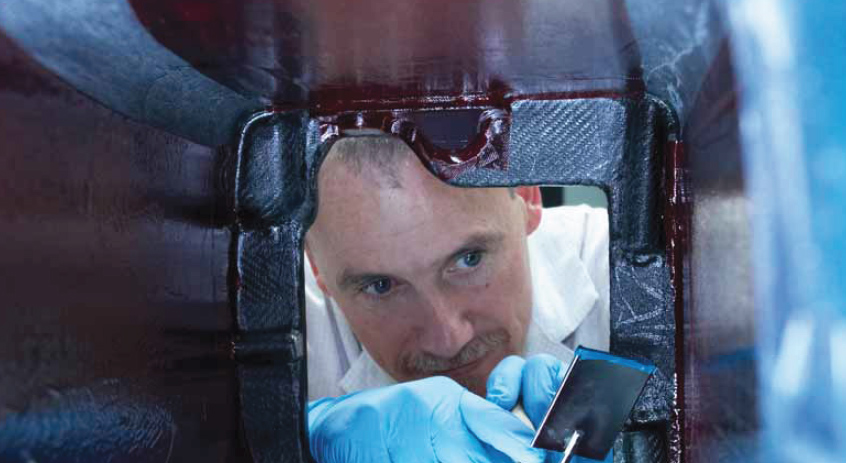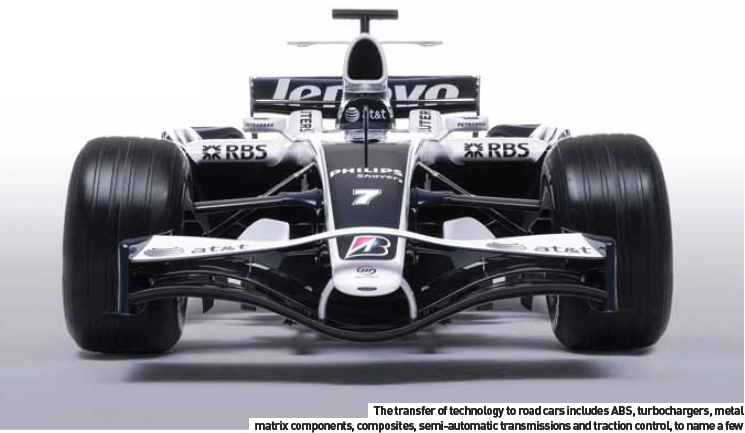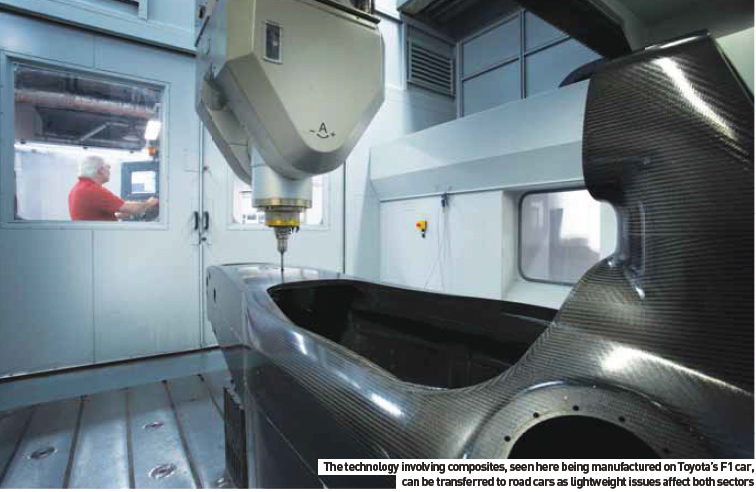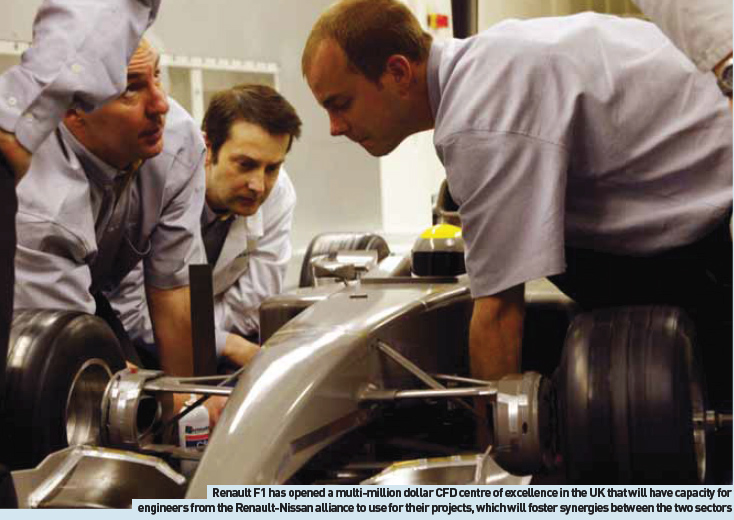
Running a Grand Prix racing team is not a cheap exercise, but carmakers involved in this most elite of motor sports are counting on the spin-offs of technology transfer to their commercial products
The link between racing teams and carmakers has always been easily explained using the time-honoured adage ‘win on Sunday, sell on Monday’. For almost a century, it has been the first line of defence for team bosses attempting to rationalise the vast sums of money invested in the hope of getting track glory and the associated silverware. If this did not pacify the accountants, there was always the second reason, that of technology transfer, where a feature developed specifically for racing makes the jump across to road cars.
While many branches of motorsport technology will rightly point to their own successes in this area, Formula One – the undisputed technological pinnacle of motor racing – is the usual yardstick by which these things are judged. But F1 has been further troubled in recent years. As a sport, it rose to prominence by mixing glamour, danger, and excess. Today it is derided for precisely the same reasons: it is dangerous, is a polluter and according to its detractors, wastes billions of dollars without justification.
Fans would say these criticisms only emerge when the racing is less than compelling, but for carmakers involved in the sport there is a deeper concern: it is tough promoting yourself as an environmentally-responsible multinational doing your bit to lower emissions when your F1 car – the flagship of the fleet – burns 250 litres of fuel in a 90-minute race.
For those looking closer still, that rather grim statistic pales in comparison to the logistics operation that gets the F1 ‘caravan’ to each venue. To support the two cars weighing 600kg each at the first race of the season, each team airfreights some 30 tonnes of equipment and 80 personnel to Melbourne, Australia, the first race – and they’ll keep doing that for every race over the eight-month season.
A potential for friction
The Federation International De L’Automobile (FIA) – motorsport’s governing body – has recognised the potential for friction inherent in the situation and has, over the last few years, fostered a reorientation of the sport. New sporting regulations have been brought in to clamp down on some of the wanton excesses but more than this, there has been a vocal heralding of F1’s usefulness to the road car industry. The traditional order of marketing first, technology transfer second is being reversed. Road-relevance has become a key phrase in the F1 paddock. The problem is, nobody seems to believe it.
It’s tempting to view the deliberations of carmakers in a somewhat Monty Python-esque light when imagining them examining F1 team budgets. “What has F1 ever done for us?” they ask. For starters: ABS, turbochargers, metal matrix components, composites, semi-automatic transmissions and traction control, just to name the most well known. All these technologies were either developed for or dramatically improved by F1 teams, but they’re all comparatively old, with even the latest in the list, the semiautomatic, paddle-controlled transmission, making its debut on a Ferrari F1 car in 1990. “From a technological point, today’s F1 car bears more resemblance to a military aircraft than to a road car,” explains Renault F1’s technical director Bob Bell.
“We make extensive use of carbon fibre composites, we use sophisticated electro-hydraulic control systems and we’ve got highly complex – although not particularly pretty – aerodynamic devices all over the cars, all of which follow the pattern used in military aviation. As a result, we also incur high costs in manufacturing, all of which moves us further away from the road car business,” he tells AMS. “Historically there has been transfer of information, particularly within engine technology. I think of the turbocharging era as a good example: turbos weren’t invented in F1, though their use on the track had a significant impact on promoting their worthiness in the road car industry. Today it’s impossible to put your finger on specific technical crossovers – though it does happen, perhaps more for marketing reasons than for pure technological purposes. For example, if you look at the rear of the current Renault Sport Clio, you see the underbody has a diffuser with the little vanes on it that looks very F1-ish. I’m sure it has a benefit aerodynamically, but technically, there is a fairly tenuous connection,” Bell continues.
He thinks the biggest impact that the elite motorsport has had on road cars in recent years is the introduction, via the FIA, of EuroNCAP. “I think the idea to push that was at least partially driven by the success within F1 of quite rigorous structural and impact testing that we need to do to homologate our cars.”
Bell is among the most successful designers in the sport, his current tenure with Renault bringing the team two constructors’ and two drivers’ world championships. Renault is perhaps the best example of a team maximising its F1 exposure for commercial benefit, taking advantage of the synergies created by running a successful racing team by applying them to the model range (see box). While he makes it clear that the technology transfer isn’t high up the agenda, he suggests there may be stronger links in the future.
The future is plastic
“We certainly envisage where the road car industry is going to be, using more lightweight materials of better quality, particularly plastics. Our experience of testing those, both from a structural and energy-absorbing perspective, is probably something that will be of benefit. Beyond that, I think the biggest area of crossover is yet to come. The European Union, in a strongly-worded statement released recently, clearly believes the FIA has a mandate to use motorsport as a method of promoting environmentallyimportant issues – and researching these issues for the motor industry at large. The FIA, in demanding that F1 adopts hybrid technology, has made a clear statement of intent,” he explains.
Bell continues, “It’s very important for two reasons: it raises raises public awareness of hybrid technology and makes hybrids slightly more attractive to the buying public. On a more technical level, I’m sure the development of these systems in F1 will carry over and directly benefit the development of systems that end up on road cars.” That presupposes road carmakers are interested in hybrid technology. The Europeans – with much invested in small-capacity turbodiesels – have been distinctly lukewarm towards the idea. On the other hand, the Japanese manufacturers who pioneered this technology are keen to use their F1 teams to champion the cause – though even here there is a lack of obvious crossover.
Surprising given its recent successes, Renault has always been one of the more frugal F1 teams, certainly in comparison with others supported by car-manufacturing operations. Renault executives, including chief Carlos Ghosn, have frequently reiterated that the company is not prepared to “write a blank cheque” to fund its motorsport activities; rather, management expects the F1 team to make a significant contribution to the Group.
One aspect of this can be seen in the new $50 million (about £25 million) technology programme underway at Renault F1’s manufacturing base at Enstone, Oxfordshire, in the United Kingdom. Part of this investment has gone into creating a new CFD centre of excellence that will service more than just the development of future F1 chassis. “We very much intend that the facility will become a centre of excellence for simulation within the Renault-Nissan alliance and we, in the F1 team, will become the lead organisation for the development and use of those methods,” explains Bob Bell.
“We will have capacity available for Renault-Nissan road car engineers to use directly on their projects and equally we will be in a position to give them advice and guidance, working with them to get the best out of the tools, providing them with knowledge that they will take away when they go back to their own facilities. This has been set up to sit at the heart of the Renault-Nissan alliance – and in this we will be of very direct benefit to the road car industry,” he adds.
This latest initiative follows a pattern laid down by the Renault Partnership Programme, an agenda devised to filter road car engineers through the F1 organisation. “It’s one of the most profitable examples of the carry-over of technology in both directions,” continues Bell. “A budget has been set aside within Renault to have engineers from around the group come to work with us, both at the technical centre in Enstone and at [F1 engine manufacturing base] Viry-Chatillon. Usually this involves about 15 engineers each year, on secondment for anything from six months to three years. They come from a complete cross-section of engineering and technology disciplines.
Bringing outside skills to F1
“Generally, they don’t bring with them a specific piece of technology that we can apply to F1, and it’s even rarer they go back with something they can plug directly into a road car programme. What does happen is that they bring with them manufacturing and design skills that we don’t have access to, and they leave having improved their engineering and project managing skills – which I think means they are better, more rounded engineers when they leave. It benefits both organisations equally, and it’s been a very successful scheme. It’s also enjoyed by the engineers that take part – they go away with the belief that their careers have benefited from the experience – and that’s good for Renault also,” he says.
“We are certainly not opposed to the idea of a kinetic energy recovery system (KERS) but we do have some concerns,’ explains John Howett, President of Toyota Motorsport. “On a road car the system will be operating continually and the energy recovery, dispersion volume and utilisation is much higher than we’re going to be allowed in F1. We will have a push button system with a limit on the energy we can store. Compared to the technical challenges we will face to develop the system, the advantages are limited. If there was more freedom in terms of the complexity and operation of the system, making it closer to something like the technology used on a Prius, from our perspective that would be better,” he adds.
Passing on the skills
KERS apart, Howett is generally more upbeat than Bell on the idea of F1 ideas trickling down to road car use – though not necessary in the form of obvious technology. “An F1 car is absolutely tailor-made for the job that it is doing, and items that can be directly taken from it and applied elsewhere are rare. We need to think beyond that – if you look at the basic technologies, there is room for interchange. F1 has something to offer the commercial car business: design techniques, production skills and simulation capacity, for example. I believe an increasing number of carmakers are investing in wind tunnels because they have a requirement to improve emissions performance and therefore reduce drag. We have vast experience in these areas and obviously, that has value for our colleagues elsewhere within Toyota.
“Another good example is the use of thin-walled castings. F1 has always invested in production techniques to produce lightweight components. It wouldn’t have been something you would have seen on a road car a few years ago, but look at automotive castings today and the materials F1 has been using for years have suddenly become far more relevant because weight has become a major issue on the road. Obviously in F1 the unit price is very high and you have to industrialise those technologies to bring this to an affordable level, but I think there is a huge transfer of know-how – even though it may not be immediately obvious.”
Howett’s opinions are broadly echoed by the other car manufacturer teams racing in F1 such as BMW, Honda, Mercedes, Renault, Toyota and (via the presence of Ferrari) Fiat, but they are not the only faction in the sport. There are the privateers too and more often than not, they hold different opinions on this issue. “I don’t think there is a direct correlation between F1 and the automotive industry, but there has to be a good reason why five or six major carmakers run teams in F1,” says Patrick Head, Director of Engineering and co-owner of the Williams Grand Prix team. This is arguably the last remaining ‘pure’ privateer, with motor racing as its core business rather than an adjunct to another concern.
“I think it isn’t just the obvious appeal of marketing; there’s also the projection of the competitive image. Look at the semi-automatic gearboxes that we started running in the early 1990s – the road carmakers adopted those soon afterwards, but they didn’t take the technology straight off F1 cars. They simply liked the image F1 represented and replicated the system. The modern equivalent is the KERS. There are people who don’t find the idea of owning a Toyota Prius or Honda ‘whatever’ very appealing. Regardless of whether the technology used in F1 is of any actual relevance to a road car, if it makes the idea of owning a hybrid car sexy and compels more people to go out and buy a more efficient road car, then KERS has served its purpose,” he says.
One company that sees a definite transfer of technology between Formula One and the automotive industry is sensor manufacturer BERU, whose tyre pressure monitoring system is widely used by F1 teams and, in a very similar specification, by high-end road-going sports cars. As BERU F1 Systems’s Managing Director John Bailey explains, “The tyre pressure monitoring system came out of our mainstream automotive business, but the specifications for both hardware and software were not suitable for high-level motorsport, so we enhanced them signifi cantly to use in F1.
“From there they went into NASCAR, Champ Car, IRL and other toplevel motorsport environments. The circle was completed when we were able to use that enhanced system to meet the needs of low-volume, niche vehicle makers. The fi rst application was for the Bugatti Veyron,” he says. Surprisingly, BERU counts Bugatti as the tougher environment, based on the larger wheel size of the Veyron and the significantly higher final speed: the wheel sensor has to cope with 3000-g and therefore, a weight at top speed of around 90kg – far above anything experienced in F1.
“We learnt a great deal from motor sport,” says Bailey. “We hardened the materials to cope with high temperature and high g-force loads, and we made our software more flexible and tuneable. Everything we built for the track was very easy to transfer across to any road car programme – easy in the sense that we would be able to roll it out in days, rather than months. The experience we gained in F1 allowed us to immediately carry the system over to Bugatti with little modifi cation and from that we secured contracts with Lamborghini and some other well-known Italian marques.
“For motorsports applications we manufacture everything in-house and for Bugatti, we simply extended that operation. For other marques, where the volume is considerably higher, we develop the hardware, build up the prototypes and then outsource the manufacturing of those parts. The effective thing for us is that the business model we developed for motorsports makes us useful to automotive OE clients: everything in motorsport tends to be developed ten times faster than it would be in the automotive industry – which makes us very attractive to the automotive industry.”

Techology transfer
Head recently celebrated his 500th F1 race in a trophystrewn career with Williams that started in the 1970s. He believes it has been a long time since technology transfer vis-à-vis the automotive industry has been a viable proposition. “Obviously we use full composite construction for all the primary structures and most of the suspension components. They’ve come out of the military aerospace sector, but we’re starting to see them in civil aviation as well, with Boeing and Airbus investing in composite wing boxes and fuselages, for example.
“The manufacturing techniques are not exactly the same, but they use methods that have been pioneered in F1 because they have a labour-intensive manufacturing philosophy similar to ours – but there’s no way that could ever be viable in series road car production,” Head continues. “Moreover, the road car manufactures really don’t need F1 to tell them what they should be developing for road cars. Now more than ever they have their own issues to deal with – CO2 targets for example – that will require very specific, targeted research and development programmes that will take them even further away from us,” he contends.
He says that the carmakers are not “sitting around saying ‘we need something new, let’s take at look at F1 and see what they are doing.’ Nor are our designers sitting in their department thinking ‘I must develop something that will be relevant to road car design.’ There have been cases of transfer, but they’ve always been incidental.” If serendipity has been the root-cause of crossover in the past, then the FIA has taken steps to ensure it will not be so in the future. UK-based powertrain consultancy Ricardo has been recruited by the organisation to provide a degree of oversight in the area of future automotive trends. The end goal of the commission has not been made absolutely clear, but the assumption is that Ricardo’s expert assessment of the directions automotive technology might take will aid the FIA in shaping the future specifications of F1. It is a very different approach to the organic way in which F1 and the automotive industry have interacted in the past, but, as everyone says, F1 is becoming much more businesslike these days.


































